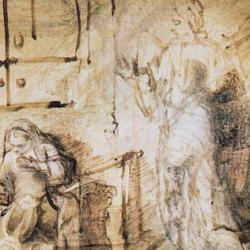In discussing “the only non-cultic text with a seemingly concrete object for kipper (Genesis 32:20), Feder argues that kapar doesn’t mean “cover” and he takes the common view that panayv doesn’t mean “his face.” Jacob does not send a gift to “cover” Esau’s “face.”
Feder’s analysis of the passage, though, fits neatly into that interpretation. He points out that “face” is used four times in the text: “I will propitiate his anger [cover his face] with this gift that goes before me [my face]. Then I will behold his face, perhaps he will show me favor [lift my face].” If we take “cover” and “face” more concretely, woodenly, the logic is this: Esau comes with an angry face. His “nose burns” again Jacob. Jacob wants a barrier between himself and Esau’s face, and the gift functions as that “veil” between them. Jacob moves toward Esau, but with some hope and confidence that the gift that goes before his face will screen Esau’s anger. If the gift achieves its purpose, then Jacob will eventually be face-to-face with Esau, and Esau will exalt/lift up his face as he bows it to the ground.
And this logic fits exactly the situation of an Israelite worshiper bringing an offering before the face of Yahweh. As kipper , the offering is an enacted “veil,” a ritual screen that covers Yahweh’s holy wrath so that the worshiper can draw near in hope that Yahweh will lift his face, in hope that he will stand before him face-to-face.










